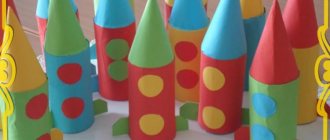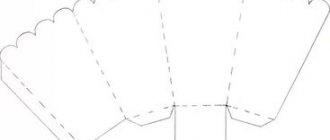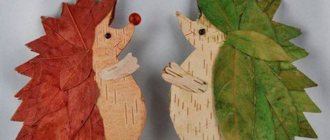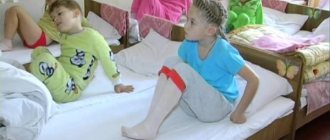Abstract of OD on design in the senior group. Circus animals
Summary of educational activities on design for children of the senior group “Circus Animals!”
Author: Skichko Olga Vasilievna, teacher, MADOU "Malvina" Noyabrsk Yamalo-Nenets Autonomous Okrug Program content: Goal:
development of the constructive abilities of older children.
Objectives:
achieve results in accordance with the set goal;
teach children to work according to a scheme and an idea; consolidate knowledge about planar geometric figures. develop fine motor skills, attention, logical thinking; develop creative abilities and the desire to participate in the creation of a building; develop the ability to work together in a team and bring what you start to the end. Materials and equipment: Demonstration:
Poster, tiger diagrams, geometric figures.
Handout:
Envelopes with geometric shapes, construction set.
Progress:
The music "Circus" is playing.
Children enter the group. Educator:
Attention, attention!
An extraordinary event happened in our city! The circus has arrived! And here is the poster for the circus performance. Who came to perform? We will now find out by solving the riddles: A white collar jumps straight across the field (hare) He sleeps in a den in winter Under a huge pine tree, And when spring comes, He wakes up from sleep (bear) I wake everyone up on time, Even though I don’t wind the clock (rooster) At the doorstep cries, hides his claws, quietly enters the room, purrs, sings (cat) And other artists can perform (schemes) Children:
Clowns, birds, animals.
Educator:
That's right, well done!
Sit down at the tables. Guys, today in class you will learn how to depict circus animals using geometric shapes and construction sets. First, let’s remember what geometric shapes you know (teacher demonstrates geometric shapes) Children:
circle, square, triangle, polygon...
Educator:
As you noticed, there are different quadrilaterals.
— They take part in a circus performance. (teacher hangs up a diagram of a “tiger”) - Speech, what predatory animals have you seen? Think about who it is? Children:
This is a tiger.
Educator:
What geometric shapes does the tiger’s body consist of?
Children:
the tiger's body is made up of two large triangles.
Educator:
What geometric shapes does the tiger's head consist of?
Children:
The tiger's head consists of a medium and small triangle.
Educator:
What geometric shapes do the front paws consist of?
Children:
the front legs consist of a quadrangle and a triangle.
Educator:
What geometric shapes do the hind legs consist of?
Children :
The hind legs consist of a square.
Educator:
Guys, who can show what geometric shapes the figure of a tiger consists of?
Open the envelopes and take out the geometric shapes. Make a tiger from these geometric shapes on your tables. The diagram will help you complete this task correctly, watch it carefully and complete it. Physical exercise. Guys, attention, attention, a cheerful clown invites you to the parade - but now you will turn into different animals. Bears - ducks - monkeys - horses. Now let's continue the lesson. Now we will learn how to lay out a tiger figure from a construction set. What parts of the construction set do you think we will use to construct the tiger? Children select the parts and lay out the tiger. Replace the missing parts with two other or similar parts. Educator:
Now guys, lay out the tiger diagram on your table. Well done, you completed the task. What a wonderful tiger he turned out to be. In a circus, all animals are trained by a trainer. And now you and I will be trainers. The teacher shows how you can rearrange the parts to change the position of the tiger, and draws attention to the diagram. Children complete the task. Guys, our tiger can still lie down, look. By analogy, children complete the following tasks using a diagram. Now, guys, look at each other, did you complete the task correctly, did you all get it done? You enjoyed training the tiger, well done, everyone completed the task. And now music is a surprise for you. And the cheerful clown has prepared a gift for you.
We recommend watching:
Abstract of educational activities for design in the senior group: Sunflower Abstract of an integrated lesson on constructive activities and speech development for older children Abstract of educational activities. Construction in the senior group on Bird Day Summary of GCD in the senior group on the New Year's theme "Winter's Tale"
Similar articles:
Summary of a lesson on cognitive development in the senior group. Poisonous mushrooms and berries
Lesson on basic safety in the senior group. Topic: Meeting a stranger
Summary of a lesson on construction with children of the second junior group “Den for a Bear”
Goal: Formation of socially significant moral qualities in children of primary preschool age.
Objectives: To repeat material about preparing wild animals for winter, to develop children’s speech, to repeat a poem about snowflakes, to develop responsiveness in children, to develop the ability to work with a construction set, to repeat knowledge of the basic colors and details of a construction set, to develop the ability to find a part from a description.
Equipment: Toy bear, envelope with a letter, large construction set, scarf, audio recordings of the Zheleznovs “Bus” and “The Bear is Dancing.”
Progress of the lesson
Guys, I came to work very early today, and the watchman gave me this letter. I read it and realized that I couldn’t cope without your help. Would you like me to read it to you?
"Dear Guys. Mishka-Toptyzhka is writing to you. I am still very small and do not understand what is happening around me. It became very cold outside. Squirrel says that winter will come soon. She dried mushrooms, berries, and stocked up on nuts. The bunny changed his gray fur coat to a white one. But I don’t know how to prepare for winter, for some reason I always want to sleep. Help me please!"
Guys, who is this letter from? What does Mishka - Toptyzhka write to us about? Why do you think he wants to sleep all the time now? What do bears do in winter? Where do they sleep? And Mishki-Toptyzhka has no den! I think we should quickly get on our magic bus and go help Mishka build a den. Do you agree?
Children turn around their chairs, the teacher-driver performs movements to the music of the Zheleznovs “Bus”.
Here we are in the forest, get off the bus. Guys, I don’t see Mishka. Look right, look left. You see? How can we find him in the forest? (Children offer options). Let's dance his favorite dance, he will hear and come to us!
Zheleznovs “The Bear is Dancing”
And here comes Mishka.
"Hello guys! Thank you for coming! You will help me now and tell me everything! Why did the squirrel dry the mushrooms and berries? Why did the bunny change his fur coat? How should I prepare for winter? Should I also change my fur coat? (No, bears sleep in winter!) Where should I sleep? But I don’t have a den..."
Guys, let's build a den for Mishka! What can we make it from?
Which construction set is more convenient for us to take in order to build faster: large or small?
The teacher gives each child the task of which construction piece to bring. For example: “Zhenya, bring a big red cube.” Children, under the guidance of a teacher, build a “den” together. The teacher asks to arrange the parts in a certain order, sorting by shape, color, and asks what the roof (scarf) can be made from. They put Mishka in the den and cover the top of the den with a scarf. Guys, to make Mishka warmer, we now need to cover the den with snow. We started learning a poem about snowflakes, let's tell it, stand around the den, repeat after me!
A snowball is quietly falling on a clearing, on a meadow,
Snowflakes and white fluffs are spinning,
They flew, rushed and lay down under the tree,
Snowflakes and white fluffs sleep quietly.
Children recite a poem in chorus and perform movements corresponding to the text.
Our snowflakes covered the entire earth with a blanket of snow. Mishka will be warm and cozy in his den; he will not be afraid of any frost. It's time for us to return to kindergarten. Take your seats on the bus quietly so as not to wake Mishka. I'll turn on the music quietly too. Ready? Go!
Here we are again in kindergarten! Where did we go? What were we doing in the forest? What did we litter the den with? And I have a little surprise for you! While you were getting on the bus, I took a photo of Mishka sleeping in our den. And I want to give it to you all as a souvenir. You can tell at home how you helped Mishka prepare for winter and color his photo (black and white drawing).
The teacher gives each child a drawing of a bear cub sleeping in a den, reading a poem by I. Tokmakova:
“Like there is snow on a hill, and snow under a hill,
There is snow on the tree, and snow under the tree.
And a bear sleeps under the snow. Hush hush. Keep quiet! »
Title: Lesson notes on construction with children of the second junior group “Den for a Bear” Nomination: Kindergarten Lesson notes, ECD / play activities Author: Svetlana Rudolfovna Rybchenko Position: teacher Place of work: Municipal educational institution “Elementary school-kindergarten No. 109 “Bukvaryonok” Location: Vologda
Date modified: December 2, 2015
Wombat paper applique
Wombat Facts:
- Wombats are marsupials, meaning they have pouches on their bellies in which they raise their babies.
- A baby wombat lives in its mother's pouch for about five months before it emerges.
- Wombats use their claws to dig burrows in eucalyptus forests and grasslands.
- Wombats are nocturnal and they are vegetarians (herbivores). They come out at night to eat grass, bark and roots.
- A wombat that burrows in fields can be a destroyer of ranches and crop-dependent farms.
Anteater applique
Anteater Facts:
- They are edentulous animals, meaning they have no teeth at all.
- Anteaters use their long tongues to swallow 35,000 ants and termites every day!
- They find food by smell.
- Anteaters live in tropical forests and grasslands of Central and South America.
- They live for about 14 years and are classified as endangered.
Origami animals for older adults
Older children can try making animals using the origami technique with more steps. Large voluminous origami animals also look very beautiful.
Beginning adult craftsmen and older children can make any animal and use a more complex method of work, as well as various decorative elements.
a lion
The kings of beasts are one of the most beloved animals of both adults and children. There is one interesting way how you can make it in the form of origami, you just need to prepare:
- orange or brown paper;
- ruler;
- pencil;
- scissors.
Creating origami from paper for beginners step by step animal lion:
- Draw a square with sides 24 cm and cut it out.
- Fold the square diagonally to form a triangle, mark the fold line and straighten it.
- Fold the bottom part along the center line.
- Repeat the previous step with the top part.
- Fold a small corner on the left side.
- Repeat the previous step with the upper part.
- Turn the workpiece over, step back 2 cm from the top and bend the corner.
- Repeat the previous step on the opposite side.
- Turn the workpiece over and fold it in half along the line.
- Fold the top corner, then fold it inward.
- Point the top corner down.
- From the lower right side, turn the corner so that the back of the lion comes out.
- To get the paw, you need to fold the lower sharp corner down.
- Turn the corner again, but forward.
- Draw eyes, nose, mouth, mustache.
Squirrel
To create a furry animal you need to prepare a square of brown or orange paper.
Detailed master class on creating a squirrel:
- Fold the square diagonally, then unfold and fold in half.
- Fold two sides towards the center to form a square.
- Expand the work.
- Bend all corners.
- Turn the triangles out so that “pockets” are formed.
- Turn the product over, pointing the corners of the triangle towards the middle.
- Fold the product in half.
- Along the contour of the large triangle, bend the workpiece to one side and then to the other.
- Return to original form.
- Turn the triangle inside out and fold in the resulting corners.
- Direct the sharp corner to the wrong side.
- Hide the sharp corner on the muzzle inside, straighten the triangles on the sides to form paws.
- Complete the necessary elements.
Summary of the design lesson “How we build houses for pets”
Main part. Introduction to the topic of the lesson.
The teacher suggests paying attention to the screen.
A presentation of “architecture” is shown on the screen. The teacher, together with the children, comment on photographs of buildings projected on the screen, noting the materials, beauty and unusualness of the structures.
A slide with a picture of a kindergarten appears on the screen. Children recognize the building. Together with the teacher, they describe the external and internal structure of the building.
Educator:
What is a kindergarten? (this is a house for the guys) Why was it built? (for children to play, study, eat, sleep, draw, dance here) What is the difference between a kindergarten and a house where pets live? (comfortable, beautiful, cozy)
Slides with images of animal dwellings appear on the screen, the teacher clarifies the names of the buildings and the names of the animals living in these buildings, and together with the children note the strength and safety of the structures.
Goal setting and activity planning.
A video of the appeal of Lego men is shown on the screen. “We traveled around the Perm region and saw animals grazing in meadows and fields, they probably have no shelter, who can help them?”
Educator:
Do you want to help them? (yes) Now I suggest you play architects. To play, you need to divide into teams using stickers and occupy your tables with construction sets based on color and receive a task to build houses for animals together. The hardest part will be designing the animal. Can you handle it? (yes) Then choose stickers and go to your tables.
Children are divided into teams of 4 people and take seats at the tables.
Educator:
Before we start, please tell me what we will do?
Children describe the sequence of actions, open envelopes with diagrams of animals, an illustration of a building, and construct homes for pets.
Work in groups.
During the activity, the teacher checks whether the building has windows and whether the animal will pass through the doors. The teacher plays the role of a tutor, advises children, and helps solve difficulties.
Children say they are ready and play with the building with animals.
When the children finish constructing the buildings, the teacher invites the children to come to the table of one of the teams.
Project protection
The teacher invites the children to tell what they did, why they built the building and what it is called. He asks if they succeeded in what they had in mind. Children evaluate their work and conclude that everyone completed the task. Children also take turns moving from table to table.
Reflection.
The teacher draws attention to the screen where Lego men say words of gratitude to the children for their help.
Paper applique Raccoon
Raccoon Facts:
- Raccoons will eat anything. Insects, mice, fish, eggs and even garbage!
- Because they eat almost anything, you can find raccoons in any environment - from the farm to the city!
- Raccoons love to live in hollows, logs, and even attics! Young raccoons often spend the first two months of their lives high in tree holes until their mother drops them to the ground.
- Raccoons typically live 2-3 years in the wild.
- Northern raccoons hibernate - they binge on food to store fat and then sleep in their den all winter.
Howler monkey paper applique
Howler Monkey Facts:
- Howler monkeys live in tropical areas of Central and South America.
- They howl so loudly that they can be heard up to 5 km away.
- They have what is called a "prehensile" tail, which means they can use it as an extra hand to grasp branches.
- Howler monkeys can live 15-20 years in the wild.






